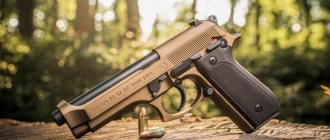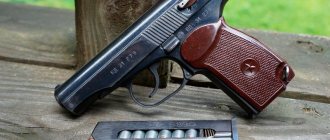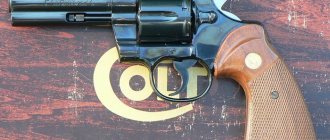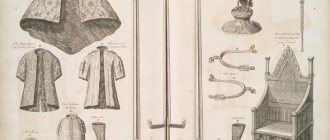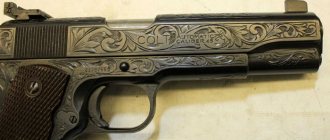Author: ARON
10 July 2022 10:43
Community: Military
Tags: history pistols trunks
8599
17
It is believed that the first pistol was invented by Italians in the city of Pistoia, from whose name the word “pistol” itself comes. Hand-held firearms in the form of all kinds of arquebuses, arquebuses and muskets were created much earlier, but they were suitable only for use by foot soldiers. For cavalrymen, a lighter and more compact type of weapon was required. The pistol became such a weapon.
0
See all photos in the gallery
Grandpa Colt "Peacemaker"
0
“God created people different, and Colonel Colt equalized them in rights”—that’s roughly what one version of the catchphrase goes. There had been attempts to create a multi-shot pistol before, but it was the Colt revolver that became the next starting point in the development of firearms. In 1836, Samuel Colt made and patented his first revolver, called the Colt Paterson. It was a 36-caliber pistol with a rotating drum for five capsule charges. Moreover, the drum did not rotate manually, but using a mechanism, which made the revolver truly semi-automatic. The trigger mechanism (trigger mechanism) is single action, i.e. the hammer had to be cocked before each shot. The Paterson was followed by a number of capsule revolvers (Walker, Dragoon, etc.). But they all had a significant drawback - a very long reload time (first the capsule was loaded, then the powder charge, then the bullet), which essentially made the revolver useless after five shots in battle. More advanced weapons were required. In 1873, a revolver was created, which became a real legend, a symbol of the Wild West and the most popular weapon in Westerns. It was called the Colt Single Action Army, Model 1873, or popularly known as the “Colt Peacemaker.” And it was about him that the catchphrase was invented. Unlike earlier, capsule models, the “Peacemaker” was a center-fire revolver, loaded with unitary cartridges with a metal sleeve. The revolver was adopted by the US Army as a service weapon and remained the main army pistol until 1892.
×
0
Characteristics: Weight - 1.021 kg uncharged. Length - from 260 to 330 mm depending on the model. Caliber - 45 Colt (11.43 mm). Drum capacity - 6 cartridges. “Peacemaker” was distinguished by its high power, rate of fire (for that time) and reliability. Therefore, following the army models, the revolver also received a civilian, lightweight version for a smaller caliber. The 1873 model became so popular that it was produced until 1941 and sold a total circulation of more than 357 thousand pieces. It is still produced in limited quantities on special orders.
Colt Paterson
In late 1836, Colt's Patent Firearms Manufacturing Company in Paterson, New Jersey began production of Colt's five-shot .28-caliber cap revolvers, sold under the name Colt Paterson. In total, until 1842, 1,450 revolving rifles and carbines, 462 revolving shotguns and 2,350 revolvers were produced. Naturally, all weapons were percussion caps. The first samples were characterized by low reliability, regular breakdowns and a very imperfect design, not to mention the extremely unsafe and inconvenient reloading process. Not surprisingly, the US government showed little interest in the new weapon. The Army purchased only a few revolver carbines for testing. The largest customer for Colt's company was the Republic of Texas, which bought 180 revolving shotguns and rifles for the Rangers, and about the same number of revolvers for the Texas Navy. A number of revolvers (more powerful caliber - .36) were ordered privately by the Texas Rangers themselves with their own money. Low demand in 1842 led to the bankruptcy of the factory.
Colt Paterson made 1836-1838 (still without loading rod)
Thus, the most popular Colt Paterson revolver model produced in Paterson was the No. 5 Holster, also known as the Texas Paterson, a .36 caliber revolver. About 1,000 units were produced. Half of them occurred in the period from 1842 to 1847, after bankruptcy. Their production was established by Colt's creditor and former partner John Ehlers.
Colt Paterson 1836-1838 with the trigger retracted
One of the most significant conflicts involving the use of Colt Paterson revolvers was the Battle of Bander Pass between the Mexican Army and Texas Rangers, among whom was US Army Captain Samuel Walker. Later, during the Mexican-American War, Walker met Colt and together with him modified the Colt Paterson revolver, called the Colt Walker. There was good demand for it, since the Colt Walker was much more reliable and convenient than its predecessor. Thanks to this, Colt returned to developing weapons in 1847.
Hard worker revolver
0
At the end of the 19th century, massive rearmament of the army began in Russia. In parallel with the choice of a rifle (the winner of the competition was the famous three-line Mosin model of 1891), a competition was announced for a new revolver. The winner was the Nagan brothers arms factory, located in the Belgian city of Liege. The Russian military presented a number of demands. So, the caliber of the pistol had to correspond to a rifle - 7.62 mm. At the same time, the revolver had to have sufficient destructive power, good accuracy of fire and weigh in the range of 800-900 g. And also be easy to use, technologically advanced in production and reliable in operation. Surprisingly, all these requirements were implemented in the Nagan system revolver. In 1893, the revolver was adopted by the Russian army in two versions - soldier and officer. The latter featured self-cocking, while the former did not (to simplify the design and reduce cartridge consumption). Characteristics Weight - 0.795 kg unloaded, 0.880 kg with cartridges. Length - 220 mm. Caliber - 7.62 mm. Drum capacity - 7 rounds. The initial bullet speed is 272 m/s. The Nagan system revolvers turned out to be so successful that they became widespread throughout the world - from Argentina to Vietnam. Nagants were produced both in Belgium itself and in Russia, Poland and other countries. The total circulation of the pistol was more than 2 million pieces, the largest number of which were used in Russia and the USSR.
0
Even after the advent of more powerful, faster-firing and advanced semi-automatic pistols, the revolver for a long time enjoyed well-deserved love for its unpretentiousness, reliability, the ability to fire after a misfire and high accuracy. During World War II, revolvers were produced in parallel with the TT and were widely used by both the Red Army and the Wehrmacht in the form of trophies.
Comrade Mauser
0
It is difficult to find a more brutal and charismatic example of a hand weapon than the Mauser K96 self-loading pistol, the main competitor to the revolver as a symbol of the Civil War. The integrity of the image of a red commissar in a black leather jacket or a bearded basmach was complemented by a huge Mauser in a polished wooden holster. The pistol was created by the Federle brothers, who worked in an armory. In 1895, it was patented by one of the owners of the company, Paul Mauser, under the symbol “Mauser K96” (English: Mauser C96). Initially, the pistol was developed for the powerful Mauser 7.63×25 cartridge. Subsequently, the K96 received many modifications for various types of ammunition, including 9x19 Parabellum. There were modifications capable of fully automatic fire! The pistol itself came with a wooden holster made of walnut. It could be used as a stock, turning the pistol into a lightweight carbine with significant accuracy and range. Characteristics: Weight - 1,250 kg without cartridges. Length - 312 mm with a barrel of 140 mm. Caliber - 7.63 mm (9 mm and others). Magazine capacity - 10 rounds. The initial bullet speed is 425 m/s. The heavy, complex and very expensive weapon was not particularly interesting to the military as a mass-produced army pistol. For example, a Belgian-made revolver cost about 30 rubles, a Russian one - 22 rubles. With the price of the Mauser K96 being more than 100 rubles, it was a very prestigious and, to some extent, status weapon. Only wealthy military and civilians could afford it. Why did the Mauser gain such popularity, despite its enormous cost? The answer lies on the surface: for its fighting qualities. A bullet fired from a Mauser flew one and a half times faster than a Naganov bullet (425 m/s versus 272). The effective firing range of a Mauser, especially with an attached buttstock, was more than 100 m and was inaccessible to any other pistol of that time. In addition, the magazine capacity of 10 rounds exceeded the standard 6-7 for revolvers. A well-trained Mauser rifleman was a very dangerous opponent.
0
There were also disadvantages (in addition to the high price): large weight and dimensions, reloading using a rifle method, difficulty in manufacturing. Nevertheless, the Mauser became a real legend. In the USSR, it was a favorite type of award weapon and often starred in films (“White Sun of the Desert”, “The Elusive Avengers”). The K96 model was produced until 1939; in total, more than a million pistols were manufactured.
Colt's childhood and youth
Samuel Colt was born in 1914 in Hartford, Connecticut. Even as a child, Samuel was interested in mechanics, including his father's firearms, in order to understand the principle of their functioning. At the age of 16, he entered the Academy in Massachusetts to study navigation. However, youthful pranks led to his expulsion from the educational institution. The father gave the teenager the opportunity to study navigation by sending him to the open sea on the ship Corvo.
Here Colt became interested in studying the ship's systems, in particular, the principles of lowering the anchor and the operation of the steering wheel ratchet. He transferred these principles to firearms and came up with a device by which a single-shot pistol could be adapted to fire several times in quick succession. During his time at sea, Colt carved out the first model of the legendary revolver from wood.
After returning from his sea voyage, Samuel spent two years traveling around North America as Dr. Colt selling science shows.
Mister Luger, or Maestro Parabellum
0
“Si vis pacem, para bellum” - “if you want peace, prepare for war.” So says the famous Latinism, which has become the second name for another legend of small arms - the Luger pistol. And if the Mauser attracted the eye with its rough, terrifying beauty, then the Parabellum was the complete opposite. Elegant in execution, perfect in lines, it still remains one of the standards of weapon beauty. In 1893, German gunsmith Hugo Borchardt created a model of a pistol with an original crank (crank) locking mechanism. Based on this pistol, in 1898, another German designer Georg Luger created his much more compact and convenient 7.65 mm pistol. In 1902, a competition began to select a pistol for the Kaiser's army, the winner of which in 1904 was the modernized Luger pistol for 9 mm caliber, ahead of such serious competitors as the Mauser and Browning. A new cartridge in size 9x19 mm was developed especially for the pistol, called 9x19 Luger, or 9x19 para (short for “parabellum”). It is still used in most self-loading pistols. 9x19 para is the most popular and widespread pistol cartridge in the world. Why was parabellum so good? Firstly, it is a successful cartridge, combining strong penetrating and stopping effects. Secondly, the gun was light, compact, convenient and reliable. Third, the Luger is incredibly accurate. One “but”: it was expensive and difficult to produce. The large number of spare parts and the complexity of the mechanism required a lot of metal. In addition, this reduced the reliability of the pistol when used in harsh army conditions. Characteristics (for 9 mm): Weight - 0.88 kg without cartridges, 1 kg with cartridges. Length - 217 mm. Caliber - 9 mm (7.65 mm in early versions). Magazine capacity - 8 rounds. The initial bullet speed is 320 m/s.
0
The Luger pistol "P08" was the main army pistol of the German army in the First World War and remained so in the Wehrmacht until the advent of the simpler and cheaper "Walter P38". During World War II, Walther and Luger pistols were produced in parallel for some time. In total, from the beginning to the end of mass production, about 3 million units of various modifications of the Luger were produced.
"Colt 1911"
0
The US military, despite its historical love for revolvers, understood that self-loading pistols had a number of undeniable advantages. Therefore, before the First World War, the issue of replacing army revolvers with semi-automatic pistols became acute. The peculiarity of the American competition for a new pistol was that the US military certainly wanted to get a large 45 (11.43 mm) caliber pistol. Browning, working for , for the competition modified his 38-caliber (9 mm) model for the cartridge so desired by the Americans. In 1911, the Browning self-loading pistol was adopted under the designation “Colt mod. 1911" (eng. Colt M1911). This is how the legendary pistol was born, which served in the richest army for more than 70 years, sold all over the world with a total circulation of more than 3 million units and is actively produced to this day by many weapons companies. Structurally, it was a pistol with a single-action open hammer, power was supplied from a 7-round magazine placed in the handle. There was an additional safety on the back of the handle. Characteristics Weight - 1.106 kg unloaded, 1.256 kg with cartridges. Length - 206 mm. Caliber - 45 (11.43 mm). Magazine capacity - 7 rounds. The initial bullet speed is 246 m/s. The Colt did not have the aesthetics and accuracy of a Parabellum or the range of a Mauser, but in all its characteristics it was the best military pistol of the First World War, and also very powerful. In addition to the US Army, Colt 1911s were used by all belligerents. And this is despite the strong recoil, limited ammunition and short firing range.
0
In 1926, the M1911 was slightly modernized. The new model received the index “M1911A1” and, without any special changes, served as the main pistol of the US Army until the mid-1980s. It is still actively used in many special forces of the army and police around the world.
US expansion and arms supplies
In 1844, James Knox Polk was elected President of America. Most of all, he is remembered for his achievements in the field of territorial expansion of the United States. Making good on his campaign promises, the president seized the Republic of Texas in December 1845 and incorporated it as a new territorial entity. In 1846, the United States began a war with Mexico that lasted until 1848. The treaty signed by the two parties to this conflict in February 1848 provided that Mexico would give the States a very large territory. In addition, the states of Colorado and Wyoming significantly expanded their possessions.
Colt saw a new opportunity to grow his business during this time and collaborated extensively with the government. In 1845, the Texas Ranger, Captain Walker, on the orders of the commander-in-chief of the American army, General Taylor, initiated negotiations with Colt to begin supplying the weapons they liked so much. The first delivery was ordered for 1000 revolvers and was completed in 1847.
From then on, luck never left the gunsmith. Colt's pistols, beginning in 1848, began to be manufactured in Hartford, where his Colt Firearms Company plant was run by an inventive mechanic, E. Root. In the 50s of the 19th century, a branch of the company was founded in England. By 1856, the company was already producing 150 weapons per day.
Browning "High-Power"
0
Another famous creation of the brilliant Browning was the brother of the Colt M1911, the Browning High-Power (HP). They say that death overtook the designer (John Browning died of a heart attack) at his workbench when he was “sawing” this particular pistol. After creating the M1911, Browning worked on a pistol for the French army. Due to patent restrictions, he couldn't simply copy the M1911, so the Hi-Power design had some changes compared to the Colt. Nevertheless, both pistols are made according to the same design and are similar both externally and structurally. After the death of John Browning, his colleague Didier Savon, chief designer of the FN company, completed work on the pistol. It was he who developed a 13-round magazine for the new Browning, which is why the 1935 model Browning received the nickname High-Power - “great power.” In addition to some technical details, the main differences between the Browning HP and the Colt M1911 was the use of the successful Luger 9x19 para cartridge, thanks to which the HP was slightly smaller and lighter than its progenitor. Now we can say with confidence that it was with the advent of the 1935 model Browning that the formation of the appearance of the modern pistol was completed. And currently, most full-size army and police pistols are made according to the Browning design, chambered for 9x19 para and have a large-capacity magazine. Characteristics Weight - 0.885 kg uncharged. Length - 200 mm. Caliber - 38 (9 mm). Magazine capacity - 13 rounds. The initial bullet speed is 350 m/s. "High-Powers", like Colts, were produced in huge quantities (more than 1 million units in total) by various factories on both sides of the ocean. Moreover, both the Allies and the Axis countries were armed with pistols. For the Wehrmacht, HP were produced in occupied Belgium directly at the FN plant. The Browning Model 1935 was the weapon of choice for commandos on both sides for its reliability, convenience, and large magazine capacity. Among the soldiers of the Red Army, Brownings were very rare and were highly valued for their reliability and quality.
0
Despite the emergence of new types of weapons made of composite materials, many countries still prefer time-tested steel models. Currently, the Browning HP, like the Colt M1911, is one of the best-selling and commercially successful weapon models.
Tula Tokarev
0
Another sibling of the M1911 and the Browning HP, the TT pistol was developed in the USSR by gunsmith Fedor Vasilyevich Tokarev for a competition to replace the revolver with a new self-loading pistol. It will be difficult for an untrained person to find even a couple of differences between the TT and the Browning FN M1903. However, there was no talk of complete copying. The most important difference was the use of a very powerful 7.63x25 Mauser cartridge with a high muzzle velocity. The Russian military, as in the case of the revolver, wanted to have a weapon that was unified, if not in terms of cartridge, then at least in terms of caliber. Thus, in the USSR, defective barrels for Mosin rifles were used to make barrels for revolvers and TTs, and subsequently for PPSh. Very practical in conditions of total war! Characteristics Weight - 0.854 kg uncharged. Length - 195 mm. Caliber - 7.62 mm. Magazine capacity - 8 rounds. The initial bullet speed is 420 m/s. In the early 1930s, the TT, along with a modified 7.62x25 cartridge, was put into service. The army has begun actively replacing the outdated revolver with new TTs. As testing and operation progressed, shortcomings were identified and work was constantly carried out to improve the design. Thus, a model was developed with a longer handle and a 12-round magazine. But its implementation was prevented by the outbreak of war. In 1942, an experimental batch of TTs was produced with a two-row magazine for 15 rounds. But the main measures during the war years were aimed not at improving performance, but at simplifying the design and increasing the manufacturability of production. From this point of view, the TT was superior to imported pistols. It consisted of fewer parts, was easy to assemble and disassemble, and could be produced on low-quality equipment by less qualified workers and even children.
0
Alas, “tete” were not highly reliable. The kit even came with a spare barrel! Production of the pistol continued until 1952, after which the Makarov pistol replaced the TT. In the 1990s, TTs again became very popular, especially in criminal structures and some special forces of the Ministry of Internal Affairs and the FSB. Today the pistol can be found in all hot spots of the planet. It is valued for its compactness, low cost and powerful cartridge, capable of penetrating most second-class body armor
Colt Dragoon Model 1848
The Colt Model 1848 Precision Army revolver was designed by Samuel Colt in 1848 for the US government to equip the US Army's Mounted Rifles, better known in the US as dragoons. Hence its name, under which the revolver went down in history - Colt Dragoon Model 1848. In this model, a number of shortcomings of the previous Colt Walker model were eliminated - the Colt Dragoon had less weight and a ramrod lock was added.
Colt Dragoon Model 1848
There were three releases of the Colt Dragoon model, differing from each other by minor improvements in the firing mechanism:
- first issue: from 1848 to 1850 about 7,000 were issued;
- second issue: from 1850 to 1851 about 2,550 were issued;
- Third issue: From 1851 to 1860, approximately 10,000 Colt Dragoon revolvers were produced, of which the US government purchased more than 8,000 units.
Thus, the Colt Dragoon was produced for 12 years. The Colt company produced about 20,000 of these revolvers. The Colt Dragoon turned out to be a very successful revolver.
Holster and belt for Colt Dragoon Model 1848
Separately, it is worth noting the production since 1848 of its pocket version, the Colt Pocket Model 1848 in .31 caliber, better known as the Baby Dragoon, especially popular with civilians.
Some performance characteristics of the Colt Dragoon Model 1848 caliber .44, with a barrel length of 8 inches:
- initial bullet speed, m/s - 330;
- sighting range, m - 70-75;
- weight, kg - 1.9;
- length, mm - 375.
The Colt Dragoon Model 1848 was used by the US and Confederate armies in the War of the North and South. A significant portion was sold to civilians.
Colt Pocket Model 1848 Baby Dragoon
